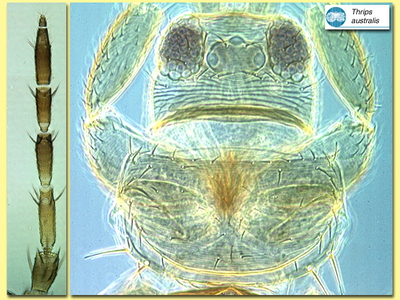Figures
Fig. 1 Antenna, head and pronotum
Fig. 2 Pronotum
Fig. 3 Head, thorax and abdomen
Fig. 4 Fore and hind wing
Fig. 5 Meso- and metanotum
Fig. 6 Tergite IV
Fig. 7 Tergite VIII
Fig. 8 Sternites V-VII
Species
Thrips australis Bagnall
Biology
Breeds in the flowers of many Eucalyptus species and also of a number of other Myrtaceae, but adults can be found in the flowers of a wide range of plants.
Distribution
Found throughout Australia, but now widely distributed around the world wherever Eucalyptus trees have been planted.
Recognition
Highly variable in colour and size; usually large and yellow with brown markings medially on each tergite and weakly shaded forewings; apex of abdomen and distal antennal segments darkest; sometimes with abdomen completely brown. Antennae 7-segmented, VII small, VI curiously 'bullet-shaped'; III & IV relatively long with small forked sense cone. Head with no setae in front of fore ocellus, one pair on anterior margins of ocellar triangle. Pronotum with 2 pairs of posteroangular setae. Metanotum with equiangular reticulation, median setae not near anterior margin. Forewing first and second vein with complete row of setae; forewing clavus with 6 marginal setae. Tergite II with 4 lateral marginal setae; V-VIII with ctenidia laterally, on VIII posteromesad of spiracle; posteromarginal comb on tergite VIII with slender microtrichia laterally but none medially. Sternites and pleurotergites with many discal setae in more than two irregular rows.
Related species
The genus Thrips includes about 280 species at present, but none of them have the terminal antennal segments similar to this species, few of them have such numerous discal setae on the sternites and pleurotergites, and most have 5 rather than 6 marginal setae on the forewing clavus. Because of this large number of setae, australis is sometimes placed in a separate genus Isoneurothrips, although this generic placement seems to have no biological significance.









